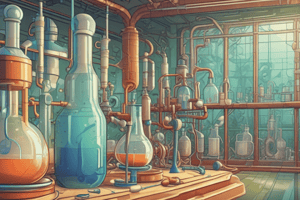Podcast
Questions and Answers
What is the main outcome of reduced GFR and normal tubular function on hydrogen ion secretion throughout the nephron?
What is the main outcome of reduced GFR and normal tubular function on hydrogen ion secretion throughout the nephron?
- Reduced hydrogen ion secretion leading to fall in plasma bicarbonate concentrations (correct)
- Increased hydrogen ion secretion leading to acidosis
- Increased hydrogen ion secretion leading to rise in plasma bicarbonate concentrations
- No effect on hydrogen ion secretion
What is the net effect of reduced GFR and normal tubular function on plasma and urine?
What is the net effect of reduced GFR and normal tubular function on plasma and urine?
- Low bicarbonate concentration in plasma, reduced urine volume
- Low urea and creatinine concentrations in plasma, increased urine volume
- High urea and creatinine concentrations in plasma, reduced urine volume (correct)
- High bicarbonate concentration in plasma, increased urine volume
What is the impact of reduced GFR and normal tubular function on potassium retention?
What is the impact of reduced GFR and normal tubular function on potassium retention?
- Increased potassium retention due to reduced potassium secretion in the distal tubule (correct)
- Increased potassium retention due to increased potassium secretion in the distal tubule
- No impact on potassium retention
- Decreased potassium retention due to increased potassium secretion in the proximal tubule
What are the typical plasma characteristics associated with reduced GFR and normal tubular function?
What are the typical plasma characteristics associated with reduced GFR and normal tubular function?
What is the impact of impaired solute reabsorption from proximal tubules on water reabsorption?
What is the impact of impaired solute reabsorption from proximal tubules on water reabsorption?
Flashcards are hidden until you start studying




